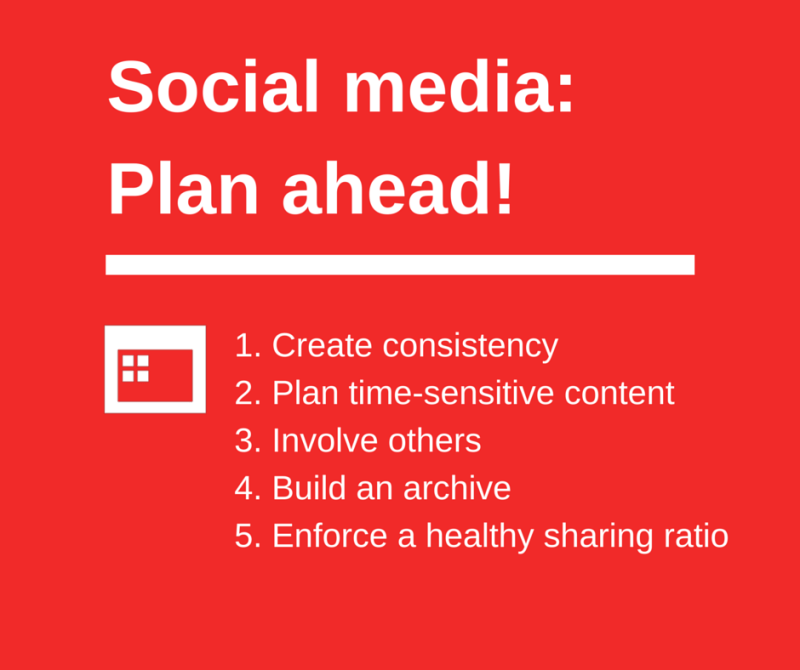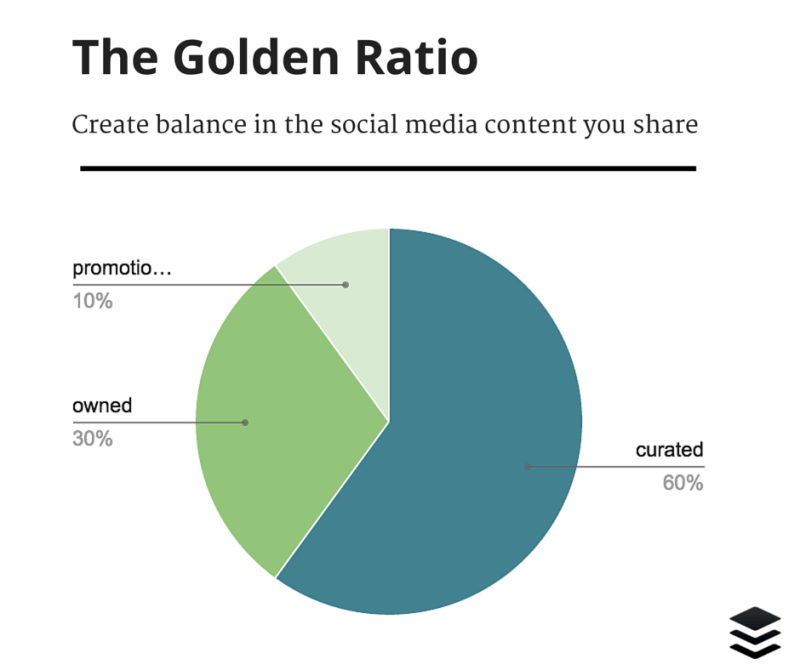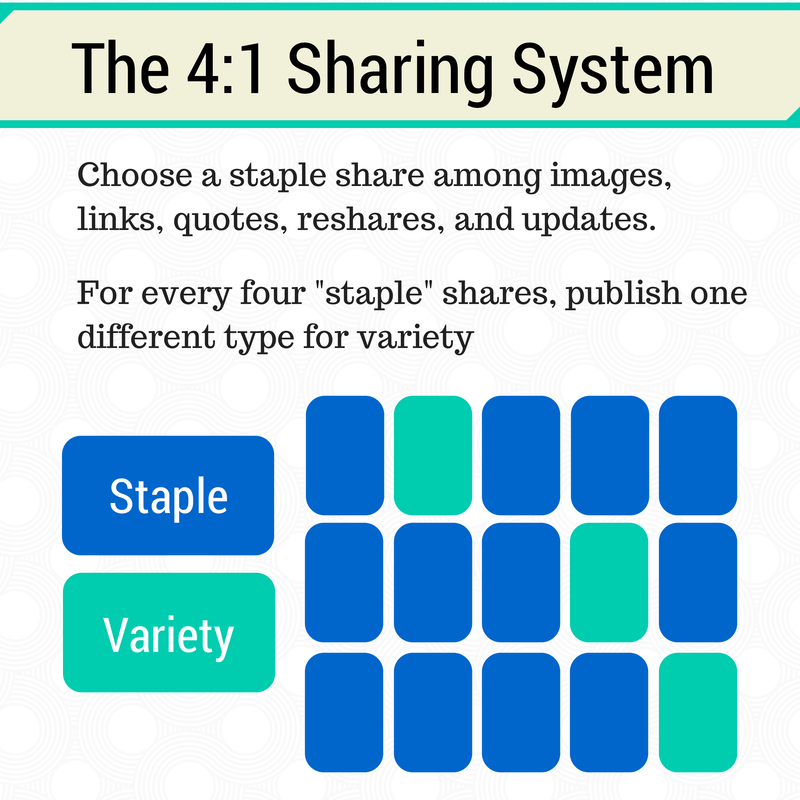When I can find the time to do so, I love to plan ahead.
I’ll write out tomorrow’s to-do list. I’ll add ideas to our content calendar. And I’ll schedule the next day’s social media updates—or even the next week’s, if I’m feeling ambitious. Maybe some day I’ll get to the point of scheduling a month or even a year ahead!
Scheduling part of your social media content in advance is well worth it and should be a part of your content strategy.
And I’ll be happy to share with you some social media marketing strategies, tips, and tools that can help you get organized and get ahead with your social media sharing.
5 benefits to mapping out your social media content
Social media content feels quite in-the-moment and real-time when you consider the short lifecycle of updates and the rapid way that information moves across social media platforms Twitter, TikTok, LinkedIn, and others.
A solid social media schedule leaves room for real-time updates on your social profiles.
Planning content on social media still allows for flexibility to the schedule and provides opportunities to slip in real-time engagement to help grow your social media presence.
The Adobe blog also has some keen insights here as well. They mention five benefits for creating a social media content calendar and planning social content ahead of time.
- It helps you maintain a consistent cadence.
- You can map time-sensitive social media campaigns and content ahead of time.
- You’ll take your social marketing out of a silo.
- It serves as a system of record.
- It enforces the “411 Rule.”

Here’s a bit more on each of these benefits.
Consistent cadence. There’s a lot to be said for consistency on social media. In terms of publishing frequency, consistency can help your audience learn when to expect new types of content from you, and keeping a consistent schedule makes sure you maximize engagement without hitting any lulls or stretches without updates on your social media accounts.
Time-sensitive content. Events, holidays, product launches, contests—many of these time-sensitive events can be planned ahead of time and placed on a calendar.
No more silo. When social media happens in real-time, it gets created and published in moments. Planning ahead allows others to become involved in the process, involving a whole team rather than a narrow silo of one or two social media managers from the marketing team.
System of record. Keeping a calendar gives you something to keep track of your content. You can track back on the updates you posted, and you can review your posting cadence and rhythm from one period to the next.
The 411 Rule. This rule refers to a ratio of sharing on social media—4 educational and entertaining posts for every 1 “soft promotion” and every 1 “hard promotion.” I’ll get into some additional ratios next.
The elements of a successful social media content plan
1. The best content rules and ratios for sharing on social media
One of the foundations of a social media content plan is figuring out the ideal ratio for the content that you’ll share. For any given slice of updates—say, your past 10 Instagram posts—what is the balance of content shared from your blog and from the blogs of others? How many product pitches do you make?
Here are some popular ratios that have been tried and tested on social. Feel free to test these and discover a ratio that is right for you, even if it doesn’t follow exactly with these. For instance, with our Buffer shares, we’ve flipped many of these ratios; our social media updates are 90 percent our own content and 10 percent from others.
4-1-1
Popularized by Andrew Davis of Tippingpoint Labs and Joe Pulizzi of Content Marketing Institute, the 4-1-1 looks like this in practice:
- 4 pieces of relevant, original content from others
- 1 retweet for every 1 self-serving update
5-3-2
Introduced by TA McCann from Gist.com, here’s how the 5-3-2 rule breaks down:
- 5 should be content from others
- 3 should be content from you
- 2 should be personal status updates
555+
- 5 updates about you and your content
- 5 updates about others
- 5 responses/replies
- + miscellaneous posts that add value like #FollowFriday or user-generated content
Golden Ratio – 30/60/10
Via Rallyverse:
- 30 percent owned
- 60 percent curated
- 10 percent promotional

Rule of Thirds
- 1/3 of your updates are about you and your content
- 1/3 of your updates are for sharing content from others and surfacing ideas
- 1/3 of your updates are based on personal interactions that build your brand
Bonus method: Thinking about the types of updates you post
The above ratios deal with the content itself. But what about the post type? Buffer’s founder Joel came up with a neat balance of the types of updates that he used in the past to share to Twitter—links, quotes, retweets, images, and plain text updates.
His system works like this:
- Start with the basic five types of updates we all post: Links, images, quotes, reshares, plain-text updates
- Choose a “staple” update, a single type that will make up the majority of your shares
- Create a 4:1 ratio of sharing: for every four “staple” updates, publish one different type for variety

The ideal frequency to post to social media
Once you have the general framework for the content you’ll plan, the next step is to figure out the ideal frequency for your posts. Your schedule figures to be unique based on your target audience. That being said, it's all about having a consistent posting scheduling that is manageable for you to keep up with.
Here’s how often we're posting on Buffer's socials:
- Post to Twitter at least 1x a day, but aim for 2x a day
- Post to Instagram 4-5x per week (with at least one Reels post)
- Post to LinkedIn 3-4 times per week
- Post 1x per week on TikTok
- Post 1-2x per week on Facebook
Plan ahead for events and launches in your social media posting schedule
What events do you have planned for the coming year?
Which launches might you be aiming for? (You’re likely to add a few to this list, too, as the year goes on.)
What type of tentpole content did well for you last year that you might want to reproduce at a similar time this year?
Anything that you think might be penciled in for a future date in the coming year, this info can go on your social media calendar. Doing so lets you develop the content and social media strategy for these big moments ahead of time and to get others involved in the process, too.
Here’re just a few calendar events to consider:
- New product releases
- Conferences
- Annual events & meetups
- Holidays
- Major cultural events – the Super Bowl, the Oscars, etc.
- Recurring content – end-of-year lists, mid-year lists, seasonal strategies, etc.
Decide how much you’ll curate
Another element of the calendar could be your curation. If you like to share the best content from others, you’re likely to want to add some space in your calendar for queueing content from others.
Generally speaking, curation happens in the moment. You share a piece of content from other blogs and websites that has been posted recently. In these cases, you can leave some schedule slots open to fill in with curated content the day of.
There are some cases and instances where it works to share great stuff from a blog’s archives or new-to-you content that you just came across. In fact, this might help break up the short lifecycle of social media content and help us all revisit the content that’s worth a second read.
7 tools for organizing and implementing a social media calendar
With a good plan in place, the next step in your workflow is organizing and implementing. Here are some social media management tools we recommend:
- Buffer – Simple-to-use, great for scheduling social media posts in advance, and has an AI Assistant for content creation, and provides social media analytics for best times to post
- Notion - Create a fully customized content calendar template, capture your thoughts, and manage projects in one space
- Google Sheets – Powerful and scalable way to organize and track content
- Google calendar – Daily, weekly, and monthly views of a content plan (with color-coded organization options)
- Basecamp – Project management tool that can be repurposed for social media
- Trello – Add content to boards and cards, and drag-and-drop to reorder and organize
- Todoist – To-do list app
Social media content plans—daily, weekly, monthly, yearly templates
A daily social media content plan
Work one day ahead.
- What events and launches are planned for tomorrow?
- How much content do you need to plan and schedule?
- How does your sharing ratio fit with a day’s worth of content?
With a daily social media content plan, you can schedule the bulk of your content the day before, placing promotional posts of your existing content and adding curated content that appeared that day.
If you share six times to Twitter, you can schedule the six posts for tomorrow. If you use the 4-1-1 method for sharing, you make four of your six updates be content from others with a single post each for soft promotion (a blogpost of yours) and hard promotion (a CTA for your product).
A weekly social media content plan
Work one week ahead.
- What events and launches are planned for this week?
- Which new blogposts are scheduled to publish?
- How much new content do you need to find ahead of time?
- Which images could you create in advance?
Choose a day of the week to plan everything out for the following seven days. We like to have everything for the following week planned out by Thursdays so we can get it all scheduled in Buffer.
Planning a week ahead, you can fill in many of the slots in your schedule that will hold posts from your archives—the reshared content that you’ve posted before and evergreen content. New content and curated content can join the schedule as the week progresses.
A monthly social media content plan
Look one month ahead.
- What events and launches are planned for this month?
- What are your goals and plans for content this month?
- Which content can you schedule in advance, and what will you need to reserve space for?
- What experiments might you be running?
One month ahead, you may still be able to fill some of your slots with content from your archives. Beyond that, you’ll likely be charting your strategy instead of hand-writing individual updates.
Your monthly calendar can include your sharing ratio and content types. You can plan your social media experiments and tests. You can look ahead to launches and holidays and plan accordingly.
A yearly social media content plan
Look a full year ahead.
- What events and launches are planned for the year?
- What sharing ratio will you start out with?
- What will be your daily frequency to start?
- Which tentpole content do you hope to publish?
Jot down the major events happening over the next 12 months, integrate the social media plan with a blog editorial calendar, and settle on a sharing ratio that feels best to you. You can always come back throughout the year and change and tweak anything you’d like—when planning a year in advance, it’s hard to tell exactly what will be happening three or six or 12 months from now.
Over to you
What methods have you used for planning your social media content in advance and scheduling posts?
I hope you can take away some useful tips and strategies here. Our social media team is currently experimenting with some week-ahead planning for our social media content, and we’re learning tons along the way! If you’ve got any tips to share or questions to ask, feel free to leave a comment here!










